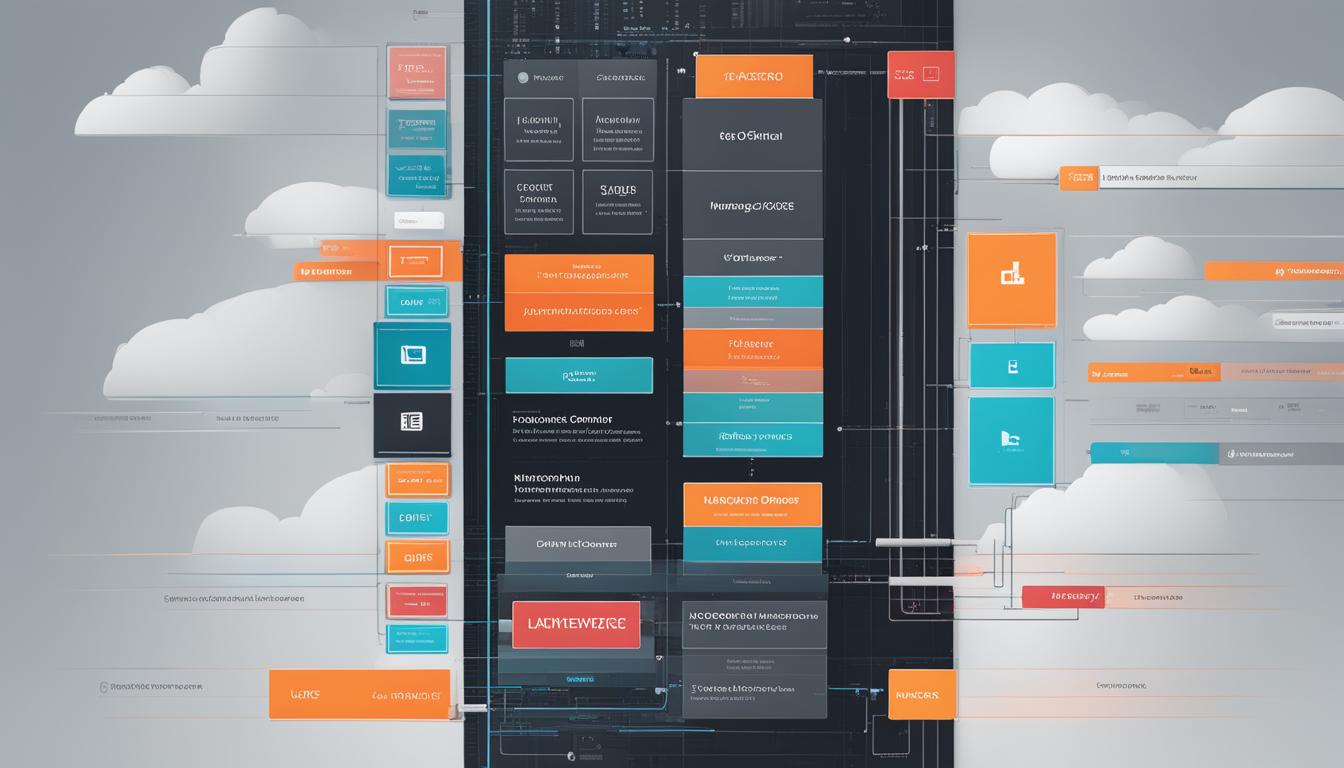Uber, the renowned ridesharing platform, has revolutionized the transportation industry with its innovative technology stack. Behind the scenes, Uber employs a variety of information technologies to power its platform, from frontend and backend technologies to infrastructure technologies.
In terms of software development, Uber’s engineering team utilizes a range of programming languages, such as Python, Node.js, and Go, to build robust and scalable applications. These languages enable Uber to handle the millions of requests and real-time operations critical to its ridesharing service.
When it comes to frontend technologies, Uber relies on React.js, Redux JS, and Mapbox GL JS to create a seamless user experience. These technologies enable Uber to develop interactive interfaces, manage complex application state, and provide accurate mapping and navigation services.
Uber’s infrastructure is built on a hybrid cloud model, leveraging multiple cloud providers for high availability and resilience. Apache Cassandra and Apache Kafka are utilized for data storage and real-time data processing, ensuring scalability and fault tolerance. Docker and Kubernetes enable efficient containerization and orchestration of services, while gRPC facilitates effective communication between microservices.
Furthermore, Uber harnesses the power of data analytics, machine learning, and artificial intelligence (AI) to enhance its services. These technologies enable Uber to optimize driver routes, predict rider demand, and enhance rider experiences.
Through its comprehensive tech stack, Uber has transformed the ridesharing landscape and set new standards for excellence in technology-driven businesses.
Contents
Key Takeaways:
- Uber relies on a diverse range of information technologies for its ridesharing platform.
- The tech stack includes frontend technologies like React.js and backend technologies like Python and Node.js.
- Uber’s infrastructure utilizes a hybrid cloud model and utilizes technologies like Apache Cassandra, Apache Kafka, Docker, Kubernetes, and gRPC.
- Data analytics, machine learning, and AI play a crucial role in Uber’s operations.
- Uber’s technology stack has revolutionized the ridesharing industry and set new standards for technological innovation.
Frontend Technologies of Uber Tech Stack
Uber utilizes several frontend technologies to create a user-friendly experience on its platform. These technologies are carefully chosen to ensure efficient performance and seamless functionality. Let’s explore the key frontend technologies employed by Uber:
React.js
One of the primary frontend libraries used by Uber is React.js. This JavaScript library enables the creation of reusable UI components, making it easier to build scalable and interactive user interfaces.
“React.js has allowed us to build a modular and flexible frontend architecture, empowering our development teams to deliver a cohesive user experience across different platforms.” – Uber Frontend Engineer
Redux
Uber relies on Redux JS for efficient management of complex application state. By using Redux, Uber ensures that the data flows predictably and consistently throughout its frontend components.
Mapbox GL JS
To provide users with interactive maps, Uber leverages Mapbox GL JS. This powerful JavaScript library enables the seamless integration of interactive maps into the Uber app, allowing users to visualize their ride routes, explore pickup and drop-off locations, and track their drivers in real-time.
Webpack
Uber uses Webpack as a module bundler to optimize the performance of its frontend applications. Webpack simplifies the process of managing and bundling different modules, resulting in faster load times and efficient code splitting.
Node.js
Node.js is another essential component of Uber’s frontend tech stack. It plays a crucial role in the frontend build process, allowing developers to run JavaScript on the server side and build efficient and scalable web applications.
By combining these frontend technologies, Uber delivers a seamless and engaging user experience on its ridesharing platform.
| Frontend Technologies | Key Features |
|---|---|
| React.js | Allows for the creation of reusable UI components |
| Redux | Efficient management of complex application state |
| Mapbox GL JS | Enables interactive map integration |
| Webpack | Optimizes performance by bundling modules |
| Node.js | Runs JavaScript on the server side for efficient web app development |
Backend Technologies of Uber Tech Stack
Uber’s backend tech stack forms the backbone of its ridesharing platform, handling millions of requests and managing the complex logistics involved. The backend technologies employed by Uber encompass a diverse range of tools and frameworks designed to ensure scalability, reliability, and efficient data processing. Let’s explore the key backend technologies that power Uber’s platform:
1. Python
Python serves as the primary programming language for Uber’s backend services. Renowned for its simplicity and readability, Python enables Uber to develop robust and scalable applications efficiently. It powers various components of Uber’s backend infrastructure and plays a crucial role in handling request routing, data processing, and system integration.
2. Node.js
Node.js, a lightweight and efficient JavaScript runtime, is widely used by Uber for building real-time applications. With its event-driven architecture and non-blocking I/O operations, Node.js offers high performance, making it well-suited for managing concurrent requests and delivering real-time updates to users.
3. Go (Golang)
Go, also known as Golang, is another key programming language utilized by Uber. Recognized for its strong support for concurrency and efficient memory management, Go enables Uber to build scalable and resource-efficient backend services. It is often employed for high-performance tasks, such as handling real-time data streams and powering Uber’s dispatch and routing algorithms.
4. Apache Cassandra
Uber relies on Apache Cassandra, a highly scalable and fault-tolerant distributed database, for managing and processing massive amounts of data. Cassandra’s distributed architecture and tunable consistency make it an ideal choice for storing and retrieving data in real-time at Uber’s scale. With its ability to handle high data write and read throughput, Cassandra ensures that Uber can process millions of requests seamlessly.
5. Apache Kafka
Apache Kafka forms the backbone of Uber’s data pipeline, facilitating reliable and real-time data streaming across various components of the platform. Kafka’s distributed and fault-tolerant architecture enables Uber to handle immense volumes of event data, providing seamless integration between different services. It plays a crucial role in ensuring data consistency, reliable message delivery, and real-time analytics at Uber.
6. Docker and Kubernetes
Docker and Kubernetes play a pivotal role in containerization and orchestration within Uber’s tech stack. Docker allows Uber to package applications and dependencies into lightweight containers, ensuring consistency and portability across different environments. Kubernetes, an open-source container orchestration platform, simplifies the deployment, scaling, and management of Uber’s backend services, enabling seamless scaling to handle fluctuating user demands.
7. gRPC
Uber leverages gRPC, a high-performance open-source RPC (Remote Procedure Call) framework, for efficient communication between microservices. With its language-agnostic nature and support for bidirectional streaming and flow control, gRPC enables Uber’s microservices to communicate seamlessly and reliably. This robust communication framework contributes to the overall performance and responsiveness of Uber’s platform.
8. Jaeger
Uber has developed Jaeger, a distributed tracing system, to monitor and optimize its microservice architecture. Jaeger provides valuable insights into the performance and interdependencies of various microservices, enabling Uber to identify and resolve bottlenecks effectively. By tracing requests across different services, Jaeger enhances Uber’s ability to optimize latency and enhance overall system efficiency.

| Backend Technologies | Key Features |
|---|---|
| Python | Primary programming language for backend services |
| Node.js | Efficient JavaScript runtime for real-time applications |
| Go (Golang) | Scalable and resource-efficient language for backend services |
| Apache Cassandra | Distributed database for managing large datasets in real-time |
| Apache Kafka | Streaming platform for reliable real-time data processing |
| Docker and Kubernetes | Containerization and orchestration for scalable deployment |
| gRPC | Efficient communication framework for microservices |
| Jaeger | Distributed tracing system for monitoring and optimization |
Infrastructure Technologies of Uber Tech Stack
Uber’s infrastructure tech stack is a sophisticated combination of technologies and services that ensure the seamless operation of its ridesharing platform. By leveraging multiple cloud providers, Uber achieves high availability and resilience for its services.
Uber’s infrastructure technologies encompass various components that enable efficient data storage, processing, containerization, orchestration, communication, and monitoring. Here are some key technologies utilized by Uber:
Cloud Providers
Uber relies on a hybrid cloud model, utilizing multiple cloud providers for its infrastructure needs. This approach ensures redundancy and allows Uber to scale its services as per demand while maintaining reliability and resilience.
Data Storage
For scalable and fault-tolerant data storage, Uber utilizes Apache Cassandra. This distributed database management system enables Uber to handle large volumes of data effectively.
Data Processing
Uber processes real-time data using Apache Kafka. This distributed streaming platform enables efficient capture, storage, and processing of data, facilitating real-time analytics and insights.
Containerization and Orchestration
Uber utilizes Docker and Kubernetes for efficient containerization and orchestration of its services. This allows Uber to deploy and manage applications seamlessly, optimizing resource utilization and facilitating scalability.
Communication
Efficient communication between microservices is crucial for Uber’s platform. Uber employs gRPC, a high-performance and open-source remote procedure call (RPC) framework, to facilitate communication between its microservices.
Monitoring and Troubleshooting
To ensure the smooth functioning of its microservice architecture, Uber utilizes Jaeger, a distributed tracing system. Jaeger enables Uber to monitor, troubleshoot, and optimize the performance of its services, helping deliver a seamless experience to users.

As Uber continues to scale its services, these infrastructure technologies play a vital role in ensuring the reliability, performance, and scalability of its ridesharing platform. By leveraging these advancements, Uber can handle massive amounts of data, deliver low-latency responses, and provide a seamless experience to its millions of users worldwide.
Conclusion
The success of Uber can be attributed to its innovative and robust tech stack, which has revolutionized the ridesharing industry. By leveraging cutting-edge technology and constantly optimizing its platforms, Uber has become a global leader in the transportation sector.
Looking ahead, the future of enterprise data apps is likely to follow a similar model to Uber, with real-time digital twins representing businesses. These data-driven applications will provide businesses with valuable insights and enable them to make informed decisions.
If you are considering starting an Uber-like business, there are several approaches you can take. One option is to integrate the Uber API into an existing app, leveraging the power of Uber’s technology and brand recognition. Another option is to build a similar app from scratch, tailoring it to meet the specific needs of your target audience.
Regardless of the approach you choose, the key to success lies in focusing on user experience, understanding the market, and leveraging the right technologies. By combining a user-friendly interface with advanced features and reliable infrastructure, you can create a platform that not only attracts users but also delivers a seamless and enjoyable experience.
FAQ
What are the information technologies used by Uber?
Uber uses a combination of frontend, backend, and infrastructure technologies to power its ridesharing platform.
What frontend technologies does Uber utilize?
Uber employs React.js for creating reusable UI components, Redux JS for managing application state, Mapbox GL JS for interactive maps, Webpack for performance optimization, and Node.js for the frontend build process.
What backend technologies are used by Uber?
Uber utilizes Python as the primary programming language for backend services, Node.js for real-time applications, Go for specific functions, Apache Cassandra and Apache Kafka for data management and processing, Docker and Kubernetes for containerization and orchestration, gRPC for efficient communication between microservices, and Jaeger for monitoring and optimization.
What infrastructure technologies does Uber rely on?
Uber leverages multiple cloud providers for high availability and resilience, Apache Cassandra for scalable data storage, Apache Kafka for real-time data processing, Docker and Kubernetes for efficient containerization and orchestration, gRPC for smooth communication between microservices, and Jaeger for monitoring and troubleshooting.
What is the key to Uber’s success?
Uber’s success can be attributed to its innovative and robust tech stack, which has revolutionized the ridesharing industry. The key is to focus on user experience, understand the market, and leverage the right technologies to create a successful platform.




